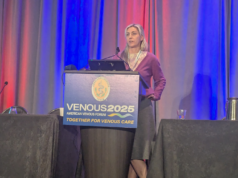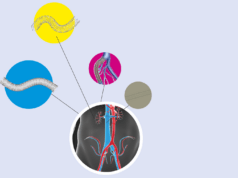
Clinical data presented at the 2019 European Cardio-Thoracic Surgery (EACTS) annual meeting (3-5 October, Lisbon, Portugal), from two prospective trials of the VEST external stent for vein grafts during coronary artery bypass surgery (CABG), showed low major adverse cardiac and cerebrovascular events (MACCE) rates up to three years, excellent patency rates and a significant reduction in the progression of vein graft disease.
David Taggart (John Radcliffe Hospital, Oxford, UK) presented the results of the VEST III trial at the late breaking clinical trials session. VEST III is a randomized controlled trial that enrolled 184 patients in 14 centres across Germany, Austria, Israel and the UK. At two years, the trial met its primary and secondary endpoints, showing superior perfect patency rates (Fitzgibbon I) of externally stented vein grafts compared to the control group (66.4% vs 53.6%, p value = 0.02) and a highly significant reduction of 25% (p value <0.001) in both intimal area and thickness assessed by intravascular ultrasound (IVUS).
“The results of the VEST III trial confirm our previous observations regarding the bio-mechanical effects of external stenting,” said Taggart. “This is another milestone in our ongoing efforts to improve coronary surgery and patients’ quality of life. As the principle investigator of the first-in-human VEST I trial in 2011, and someone who has closely followed the evolution of this technology in the last 10 years, it is very satisfying to see how the combined effort of surgeons, scientists and innovators has led to a technology with high clinical impact.”
Luca Weltert (European Hospital, Rome, Italy) presented interim results from a led all comers study that evaluated angiographic and clinical outcomes in 51 patients. The majority of patients underwent off pump CABG (77%) and all vein grafts were supported with the VEST external stent. CT angiography was performed at one year and patients were prospectively followed every six months for MACCE.
Although the average age of the study cohort was 73.5, with 32% of patients having had a prior primary coronary intervention (PCI), at average follow-up of 3 years, MACCE rates were 2% with only one patient requiring revascularisation to a de-novo coronary lesion. At one year, CT angiography demonstrated 100% patency of the VEST externally supported vein grafts.
“It is very encouraging to see that “real world” data supports the evidence from randomized trials,” said Prof. Luca Weltert. “Very often, we see big gaps between clinical results of randomized cohorts, which are highly selective in nature, and the results in our day to day practice. Our interim follow-up data shows that at 3 years, clinical and angiographic results are superior compared to those observed in published randomised trials.”









